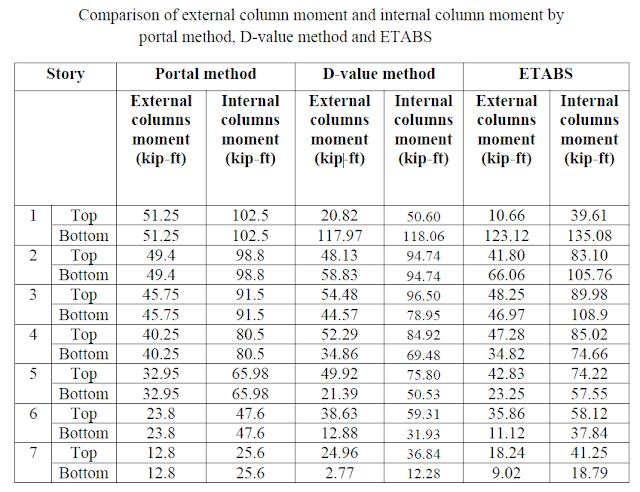INTRODUCTION
In seismic analysis the
earthquake forces are considered as lateral forces which represent the ground
motion caused by earthquake. These lateral loads can seriously damage the
structure and might even cause collapse of the structure. Comparison of portal
method, D-value method and computer program has been made for analysis of two
dimensional frame.
PORTAL METHOD
The portal method is
based on the assumptions that the shear force in an interior column is twice
the shear force in an exterior column, there is a point of inflection at the
center of each column, and there is a point of inflection at the center of each
beam.
Shear force (V)
Portal method assumes
that internal columns will take twice as much shear than the external columns,
so therefore, the ratio in which shear force is distributed here will be
1:2:2:1.
Equation for exterior
column:
Equation for
interior column:
Bending moment (M)
Equation for
calculating bending moments:
M = Shear
force x (0.5xcolumn height)
D-VALUE METHOD
This method gives a
tool for solving high static indeterminacy of the structural framing of the
building. The D-value of a resisting elements at any one story is defined by
the amount of shear reactive to the element when the relative horizontal
displacement at the story under consideration has a unit value. The D-value
method has been used for the analysis of seismic forces.
Moment of inertia is calculated using I = bh3/12.
Beam and column stiffness is calculated using K = I/L
Column stiffness is
calculated using K̅ = (K1 + K2) / Kc (Bottom
story, one end fixed) & K̅ = (K1 + K2+ K3+
K4) / 2Kc (Upper stories)
Story shear is
calculated using Vn =[ Vt / ΣDn ] Dn
Moment at bottom face is calculated using Mb = VYh
Moment at top face is
calculated using Mt = V (1-Y)h
COMPUTER MODELLING
using ETABS
ETABS is a vast but
easy to use software developed specifically for buildings and building
structures. Its function includes modeling, analytical design, and detailing
processes. ETABS help in analysis of large and complex buildings, even of
nonlinear behavior.
ETABS has the ability to
analyze the building of any possible configuration. ETABS also works on the
following stages. Inserting all the relevant information, that are geometry, material
properties, section properties, & loads and load cases. Assign material
properties, section properties of given model. Story forces are imported by
equivalent static lateral force method. Shear forces and bending moments are
obtained by analyzing the model.
RESULTS
CONCLUSION
Portal method, because of its assumptions, is not as accurate as
the D-value method upon comparison with ETABS results, but the approximations
makes this method of analysis quite simpler and thus can be used for low rise
buildings.
D-value method, being
more precise, can be used for high rise buildings where the accuracy cannot be
compromised.
Analysis by,
Aisha Iftikhar & team


























The discussion is quite informative and clear, however, I would like to be clarified as to how did you get the lateral forces acting on each node? Did you consider the weight of the whole structure or just only the weights within the frame considering tributary width as your seismic gravity load?
ReplyDelete52A84247E3
ReplyDeletetakipçi alma
swivel accent chair set of 2